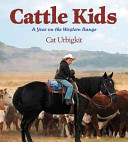
Cattle Kids, a Year on the Western Range
Written by Cat Urbigkit, 2007
Boyds Mills Press
ISBN: 978-1590785089
When searching for quality literature for children, books that are culturally authentic to the cowboy culture are difficult to find. Many books exaggerate the life of a cowboy, sending the wrong message to children. It is even harder to find books about the present day life and culture of cowboys, and so children may believe that cowboys are a part of America’s past, instead of the present. This book provides a much needed portrayal of cowboys today.
Cattle Kids tells the story of several children on their family ranches in the western part of the United States. These children live on ranches primarily in Wyoming and the book follows their daily life as they help their families throughout the course of a year. Readers can see the different events that take place, such as raising cattle, rounding them up, and shipping them to markets. All of the ranches in this book are beef cattle ranches with a focus on two kinds of cattle ranches, cow-calf outfits and yearling operations. Families who own a cow-calf outfit ranch have cows and calves. Once the calves are raised, they are sold. Families living on a yearling-only operation buy yearlings and raise them until they are old enough to be sold.
The book shows the different types of cattle and the work that goes into taking care of them. Readers will learn about branding, which is when the rancher burns the ranch’s symbol into each cow’s hide, for the safety of the herd. The first cowboys did this too; however, with technology this job is a little easier today. The author includes photographs from various ranches of the duties ranchers must perform and many of the children are in the photographs.
The author lives on a ranch near Big Piney, Wyoming, with her family. She gets her inspirations from her life on the ranch and the nature surrounding her. As a writer, photographer, and news reporter, she has written numerous books for children about life in the West. What makes her books authentic and interesting is that she incorporates her photographs. Readers love looking at the photographs and seeing children like themselves.
This book is a great way to teach children about the importance of ranch life and how cowboys still participate in the same jobs as a hundred years ago. The photographs are especially beneficial to young readers because they can see what a ranch looks like, the different kinds of cattle, and the ways that ranchers provide for their cattle. The story is centered around these vivid photographs so that readers can understand the activities. Besides being an excellent representation of ranching families, the book is also an example of families working together.
Preschoolers will enjoy this introduction to the ranch culture through illustrative photographs, and elementary students will enjoy learning about how the ranches are run and being introduced to ranch culture. For additional reading, Roxie Munro’s book, Ranch (2004) is an excellent picture book that explores the different activities of a ranch. Amazing Grazing by Chris Peterson (2011) can extend this inquiry to include the recent efforts of cattle ranchers to make environmental concerns part of their daily existence.
Brittney Beaver, Oklahoma State University, Stillwater, OK
WOW Review, Volume IV, Issue 1 by Worlds of Words is licensed under a Creative Commons Attribution-NonCommercial-ShareAlike 4.0 International License. Based on work at https://wowlit.org/on-line-publications/review/iv-1/

Hello,
How I wish I had found this posting before I submitted my changes for the paperback version of Karma! As you can imagine it is not easy to write of Indian culture as a foreigner. All assurances to readers that I did enlist the help of three Indo-Canadian writers for assistance with the language (one writer of HIndu descent and two Sikh-Punjabi writers). Not only did they read for accuracy but also made many of the additions that you refer to as incorrect. Sigh. It is so difficult to get things right. Writing Karma was a very risky undertaking that I spent three years on. To explore both a culture and the dire political situation of 1984 as an outsider was fraught with peril but I was committed to telling this important story. My hope was to bring to light the relatively unknown massacre of the Sikhs to the general community as well as write about the difficulties of immigration, identity and adolescence. It was a work of passion that I am proud of. Many thanks for taking the time to read Karma and offer your thoughts. I learned much for your post. All my best, Cathy Ostlere
Hello Cathy,
Thank you for your gracious response! I thoroughly enjoyed reading the novel and was stunned at the meticulous descriptions of daily life in India, especially considering that your first visit to India was not exactly very pleasurable. India is complex and it is very challenging to view it as a single entity or a single theoretical construct. I admire and applaud your resolve to write a novel about my homeland despite the challenges of being an outsider. And I also applaud your thematic choice for the main plot – the riots following Mrs. Gandhi’s assassination are some of the least known and least discussed topics of Indian politics. I hope you will be writing another such powerful story set in India pretty soon! Warmest regards, Shri Ramakrishnan